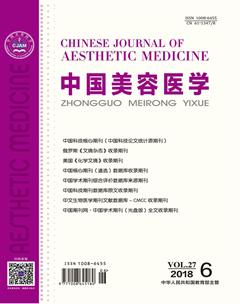上颌低位尖牙矫治的应力释放
李毕超 任利玲
[摘要]上颌尖牙唇侧异位萌出在临床上较为常见,其病因可能是因牙列拥挤导致。由于唇侧异位萌出的尖牙低位程度不一,传统固定矫治技术认为当尖牙低位严重时,矫治弓丝不可直接将其纳入,否则会导致邻牙压低局部开牙合,甚至出现牙合平面的切斜等。Damon系统则建议矫治早期尽量将错位牙纳入全牙列矫治,目前仅有文献报道尖牙异位的平均高度为(10.5±3.8)mm,而无唇侧异位萌出尖牙平均高度的研究,萌出的尖牙低位程度不一,能否将其直接纳入全牙列矫治,需要谨慎对待。本文综述了将低位尖牙纳入矫治系统后,尖牙及邻牙的应力释放情况,以期为临床矫治低位尖牙提供指导。
[关键词]异位尖牙;低位;应力释放;Damon系统;低摩擦
[中图分类号]R783.5 [文献标志码]A [文章编号]1008-6455(2018)06-0152-03
Abstract: It is more common in patients with maxillaryapically displaced canine caused by crowded dentition in literatures.The anterior openbite which was the result of the intrusion of lateral incisor and first premolar would occur when engaged the severe infraversion of canine in conventional stainless steel ligature system. Damon system recommended thatthe malposed teeth were included in the orthodonticsas early as possible. Although there are a few reports that the mean values for the distance of the displaced maxillary canines from the occlusal plane were (10.5±3.8)mm,it is still unclear about the infraversion of etrupted canine.The average height of the ectopic canine from the occlusal plane were varied,whether it can level a vertically displaced canine using a continuous arch wire directly, the stress release of the orthodontic systemwith apical canine will be the main content of this review.
Key words: displaced canine; infraversion; stress release; damon system; low friction
尖牙异位是指尖牙牙胚偏离正常萌出道而向唇颊侧(buccally displaced canine,BDC)或腭侧异位(palatally displaced canine,PDC),是牙列发育过程中一种常见的异位,常可导致尖牙阻生或异位萌出[1-3]。异位萌出(ectopic eruption)是指恒牙在萌出过程中未在牙列的正常位置萌出[4]。低位(infraversion),又称牙牙合下错位,指牙齿未萌出至牙合平面而低于牙合平面[5-6]。
1 尖牙低位的病因学
尖牙异位与尖牙发育、萌出延迟有无因果关系尚不十分明确,Becke等[7-8]认为尖牙腭侧异位(PDC)患者常伴有尖牙发育迟缓,而尖牙唇侧异位(BDC)则与之无关;Ingrid等学者[9]则认为尖牙唇、腭向异位均可能伴有尖牙发育或萌出延迟。虽然Lindauer等[10]定义尖牙阻生为未萌出尖牙牙根已发育完全者或对侧同名牙已萌出至少6个月且牙根发育完全者,但目前尚无界定尖牙异位与尖牙阻生的明确定义,对于适龄儿童尖牙尚未萌出者,大多很难准确地判断其是与尖牙异位相关的尖牙发育或萌出延迟还是尖牙阻生,而两种诊断结果所采取的治疗方法也截然不同。
流行病学研究表明:尖牙阻生发病率仅次于第三磨牙约为2%[11-13]。其较高的发病率除与遗传有关外,还与尖牙萌出时间晚,萌出道长(22mm)且扭曲相关[14]。上颌尖牙唇、腭侧异位的原因有所不同,腭侧异位常和患侧侧切牙形态异常有关,其病因学解释较为流行的是诱导学说(Guidance theory)和遗传学说(Genetic theory)。诱导学说认为侧切牙牙根的远中面为尖牙的萌出提供引导作用,侧切牙缺失或牙根异常使尖牙萌出失去引导而偏离正常萌出道致其异位阻生;遗传学说则认为尖牙异位是由遗传因素决定的,40%的患者并发有第三磨牙发育不全及牙列其他异常,如侧切牙先天缺失或发育不全等。唇侧异位阻生常与牙列拥挤相关,如乳恒牙替换障碍,乳尖牙早失等,发病率较腭侧低[14-19]。一些学者[20-21]认为唇、腭側异位阻生发生率和病因差异不大,因为多数尖牙唇侧异位阻生可自行萌出而使得发病率降低。临床常见尖牙唇侧异位萌出由于牙列拥挤而无足够空间萌出不得不唇侧低位生长。异位尖牙距离牙合平面高度平均为(10.5±3.8)mm[22],但尚无文献报道已萌出的低位尖牙距牙合平面平均高度。而Damon系统因其良好的轻力低摩擦作用,建议矫治早期即将不同程度的错位牙纳入矫治[23-24]。
2 上颌低位尖牙矫治的应力释放研究
2.1 不同矫治系统对低位尖牙及邻牙三维方向所产生的矫治力的研究:固定矫治系统弓丝对牙齿产生矫治力的大小主要与弓丝、托槽及结扎方式之间相互作用所产生的滑动阻力大小有关,而滑动阻力主要包括经典摩擦力、弹性约束力和刻痕阻力[25-26]。低位尖牙距牙合平面越高,弓丝形变产生的作用力越大,弓丝与托槽成角越大,弹性约束力也随之增大,在1mm高度时,弓丝与托槽夹角约7°,弹性约束力占滑动阻力93%;3mm高度为20°,弹性约束力占97%[24],可见滑动阻力构成中弹性约束力起主导作用。
Baccetti等[27-28]研究了自锁托槽、传统托槽与超弹镍钛丝分别在1.5mm、3mm、4.5mm、6mm高度时尖牙的受力情况发现,无论自锁还是传统托槽系统,尖牙受到的牙合向力经历由小到大又逐渐变小的过程,在3~4mm高度时自锁托槽系统尖牙所受牙合向力达到峰值,其后随着尖牙低位越严重,其所受牙合向力越小。传统托槽在4.5、6mm处所受牙合向力为0g,这是因为随着尖牙低位程度越来越大,侧切牙远中、第一前磨牙近中所受的弹性约束力也越来越大[26,29]。Badawi等[30]用Orthodontic Simulator(OSIM)仪器对弓丝进行0~4mm的加载与卸载试验,发现加载与卸载过程中尖牙受力不同,加载过程牙合向力0~4mm逐渐增大,卸载过程1.1~3.4mm高度时存在应力释放平台期,正畸治疗中纳入低位尖牙可认为是弓丝卸载过程。卸载过程中尖牙受力情况,牙合龈向:主要表现为牙合向力,并存在平台期;近远中向:主要为近中向力;唇舌向:卸载初期为舌向力之后迅速表现为唇向力。Badawi等[30]研究认为在矫正低位尖牙过程中,侧切牙和第一前磨牙的受力情况为:牙合龈向:侧切牙与第一前磨牙均受到龈向压低力作用,自锁托槽组存在平台期,而弹性结扎组的龈向压低力随尖牙高度不同趋向线性变化;近远中向:侧切牙远中向力,第一前磨牙近中向力;唇舌向:侧切牙唇向力,第一前磨牙自锁组先唇向后舌向,弹性结扎组舌向力。
2.2 低摩擦与传统托槽系统:被动自锁相对于传统弹性结扎矫治系统对尖牙低位所产生的矫治力系统更为精确,研究发现使用自锁矫治系统矫治弓丝进入低位尖牙受到的伸长力接近垂直向,产生较小的副作用力和力矩[31]。对于尖牙低位程度较轻者,传统托槽和自锁托槽差别不大,对尖牙均能产生适当的伸长力,但当尖牙低位大于3mm时,被动自锁托槽仍能释放适宜的矫治力,而传统弹性结扎在尖牙低位达到4.5mm高度时对尖牙产生的伸长力为0g。可见对于尖牙低位相对较严重者,被动自锁矫治系统滑动阻力更小,产生更为有效的矫治力,且在一定范围内能维持一定的力值水平(卸载平台期)[27-28,30-32]。
2.3 不同矫治弓丝对低位尖牙产生的矫治力研究:低位尖牙牵引力量一般应小于100g[6]。多篇体外机械力学研究表明[33-34]:在1.5mm高度时0.012、0.014inch镍钛丝在被动自锁组(自锁组)与传统弹性结扎组(传统组)对尖牙产生伸长力的大小差别不大,分别为52.5~74g、103.4~111.6g;3mm高度时0.012inch镍钛丝自锁组为78.2~96.3g而传统组约为52g,0.014inch镍钛丝自锁组为110.6~125.8g传统组约53g;4.5~6mm高度时0.012inch、0.014inch鎳钛丝自锁组41.2~85.6g、96.1~122.4g,而传统组均为0g。但由于力学实验不可能在口腔内完成,上述体外力学研究排除了软组织、牙的整体和倾斜移动、牙与牙的邻面接触、口腔湿度、唇舌压力等影响矫治力大小的因素。
不锈钢丝在一定形变范围内近似线弹性体,在该形变范围内可根据形变值估计应力大小。与之不同的是,镍钛丝在受到机械压力和温度变化的影响时可发生同素异构转变,使得其应力释放难以预测。镍钛丝可以在一定形变范围内保持力值大小基本不变(上述卸载平台期的原因),而某些情况下形变产生的应力远大于预测值。Wilkinson等[35]比较了五家制造商生产的48种商业用镍钛丝,结果表明大部分正畸镍钛丝没有或仅有一点超弹性。另外,热激活镍钛丝在低摩擦矫治系统有很好的轻力优势,但对于传统矫治器而言其轻力因无法克服矫治系统滑动阻力而无法发挥作用。基于上述原因,不同弓丝形变产生的力值大小不同,不同制造商生产的镍钛丝超弹性能有很大差别,不同托槽弓丝结扎系统产生的力系统也明显不同,对于低位尖牙除了其本身低位程度以外,弓丝的选择也应慎重。
3 小结
综上所述,因为弹性约束力的存在,不同矫治系统对尖牙产生的伸长力经历由小到大再变小的过程;被动自锁系统存在卸载平台期,而传统弹性结扎托槽系统趋向线性关系。由于口腔环境的特殊性,大多实验研究主要为体外进行的机械力学试验和电脑模拟(如三维有限元分析)等,多数试验设计多为局部的(五颗托槽)、一维的(垂直向),简化了很多解剖结构如牙周膜等,且尖牙自身存在三维方向角度,如常见的近中倾斜,这些因素都会影响矫治系统的应力释放。另外,矫治低位尖牙过程中,除了应关注矫治系统对低位尖牙产生的伸长力大小外,还应考虑矫治系统对邻牙三维方向上的副作用力,如何权衡两者,还需要临床随机对照试验结论的指导。
[参考文献]
[1]Baccetti T.Risk indicators and interceptive treatment alternatives for palatally displaced canines [J].Sem Orthod,2010,16(3):186-192.
[2]Smailiene D,Sidlauskas A,Lopatiene K,et al.Factors affecting self-eruption of displaced permanent maxillary canines [J].Medicina (Kaunas, Lithuania),2011,47(3): 163-169.
[3]Baccetti T,Leonardi M, Giuntini V. Distally displaced premolars: A dental anomaly associated with palatally displaced canines [J].Am J Orthod Dentofacial Orthop,2010,38(3): 318-322.
[4]葛立宏.兒童口腔医学[M].4版.北京:人民卫生出版社,2012:90-93.
[5]English J,Peltomaki T,Phamlitschel K. Mosby's orthodontic review [M].Mosby Elsevier,2009:29-30.
[6]陈扬熙.口腔正畸学—基础、技术与临床[M].北京:人民卫生出版社,2012:580-582.
[7]Becker A,Chaushu S. Dental age in maxillary canine ectopia [J].Am J Orthod Dentofacial Orthop,2000,117(6):657-662.
[8]Naser DH, Abu Alhaija ES,Al-Khateeb SN. Dental age assessment in patients with maxillary canine displacement [J]. Am J Orthod Dentofacial Orthop,2011,140(6): 848-855.
[9] Rozylo-Kalinowska I, Kolasa-Raczka A, Kalinowski P. Dental age in patients with impacted maxillary canines related to the position of the impacted teeth [J]. Eur J Orthod,2011,33(5):492-497.
[10]Lindauer SJ,Rubenstein LK,Hang WM,et al.Canine impaction identified early with panoramic radiographs [J].J Am Dent Assoc,1992,123(3):91-92,95-97.
[11]Sajnani AK. Permanent maxillary canines - review of eruption pattern and local etiological factors leading to impaction [J]. J Investig Clin Dent,2015,6(1):1-7.
[12]Paschos E, Huth KC, Fassler H, et al.Investigation of maxillary tooth sizes in patients with palatal canine displacement [J].J Orofac Orthop,2005,66(4):288-298.
[13]Liuk IW,Olive RJ,Griffin M,et al. Maxillary lateral incisor morphology and palatally displaced canines: a case-controlled cone-beam volumetric tomography study[J]. Am J Orthod Dentofacial Orthop,2013,143(4): 522-526.
[14]Becker A, Chaushu S. Etiology of maxillary canine impaction: a review [J]. Am J Orthod Dentofacial Orthop,2015,148(4): 557-567.
[15]Peck S,Peck L, Kataja M. Prevalence of tooth agenesis and peg-shaped maxillary lateral incisor associated with palatally displaced canine (PDC) anomaly [J]. Am J Orthod Dentofacial Orthop,1996,110(4): 441-443.
[16]Amini F,Hamedi S,Haji Ghadimi M,et al.Associations between occlusion, jaw relationships, craniofacial dimensions and the occurrence of palatally-displaced canines [J].Int Orthod,2017,15(1):69-81.
[17]Alqerban A,Storms AS,Voet M,et al.Early prediction of maxillary canine impaction [J]. Dent Maxillofac Radiol,2016,45(3):20150232.
[18]Bedoya MM,Park JH. A review of the diagnosis and management of impacted maxillary canines [J]. J Am Dent Assoc,2009,140(12):1485-1493.
[19]Rutledge MS,Hartsfield Jr JK.Genetic factors in the etiology of palatally displaced canines [J].Sem Orthod,2010,16(3):165-171.
[20]Sajnani AK,King NM.Dental anomalies associated with buccally and palatally-impacted maxillary canines [J].J Investig Clin Dent,2014,5(3):208-213.
[21]Bishara SE,Ortho D.Impacted maxillary canines: A review [J].Am J Orthod Dentofacial Orthop,1992,101(2):159-171.
[22]Grande T,Stolze A,Goldbecher H,et al.The displaced maxillary canine--a retrospective study [J].J Orofac Orthop,2006,67(6):441-449.
[23]林錦荣.正畸临床创新 [M].上海:上海世界图书出版公司,2014:22-25.
[24]Kim SJ,Kwon YH,Hwang CJ.Biomechanical characteristics of self-ligating brackets in a vertically displaced canine model: a finite element analysis [J]. Orthod Craniofac Res,2016,19(2):102-113.
[25]Kusy RP.Ongoing innovations in biomechanics and materials for the new millennium [J].Angle Orthod,2000,70(5):366-376.
[26]Kusy RP,Whitley JQ.Influence of archwire and bracket dimensions on sliding mechanics: derivations and determinations of the critical contact angles for binding [J].Eur J Orthod,1999,21(2):199-208.
[27]Baccetti T,Franchi L,Camporesi M,et al.Orthodontic forces released by low-friction versus conventional systems during alignment of apically or buccally malposed teeth [J].Eur J Orthod,2011,33(1):50-54.
[28]Baccetti T,Franchi L,Camporesi M,et al.Forces produced by different nonconventional bracket or ligature systems during alignment of apically displaced teeth [J]. Angle Orthod,2009,79(3):533-539.
[29]Kusy RP.Influence on binding of third-order torque to second-order angulation [J]. Am J Orthod Dentofacial Orthop,2004,125(6):726-732.
[30]Badawi HM,Toogood RW,Carey JP,et al.Three-dimensional orthodontic force measurements [J]. Am J Orthod Dentofacial Orthop,2009,136(4): 518-528.
[31]Fok J,Toogood RW,Badawi H,et al. Analysis of maxillary arch force/couple systems for a simulated high canine malocclusion: Part 1. Passive ligation [J]. Angle Orthod,2011,81(6):953-959.
[32]Baccetti T,Franchi L.Friction produced by types of elastomeric ligatures in treatment mechanics with the preadjusted appliance [J].Angle Orthod,2006, 76(2):211-216.
[33]Franchi L,Baccetti T,Camporesi M,et al.Forces released during sliding mechanics with passive self-ligating brackets or nonconventional elastomeric ligatures [J]. Am J Orthod Dentofacial Orthop,2008,133(1):87-90.
[34]Major PW,Toogood RW,Badawi HM,et al.Effect of wire size on maxillary arch force/couple systems for a simulated high canine malocclusion [J].J Orthod,2014,41(4):285-291.
[35]Wilkinson PD,Dysart PS,Hood JA,et al.Load-deflection characteristics of superelastic and thermal nickel-titanium wires [J]. Am J Orthod Dentofacial Orthop,2002,121(5):483-495.
[收稿日期]2018-04-15 [修回日期]2018-05-30
编辑/李阳利

